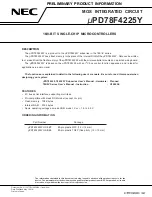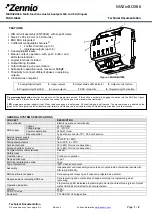DR
AFT
DR
AFT
DRAFT
DR
D
RAFT
DRAFT
DRA
FT DRAF
D
RAFT DRAFT DRAFT DRAFT DRAFT D
DRAFT
D
RAFT DRA
FT DRAFT DRAFT DRAFT DRA
UM10316_0
© NXP B.V. 2008. All rights reserved.
User manual
Rev. 00.06 — 17 December 2008
384 of 571
NXP Semiconductors
UM10316
Chapter 23: LPC2xx I2C-interface
6.2 Master Receiver mode
In the master receiver mode, data is received from a slave transmitter. The transfer is
initiated in the same way as in the master transmitter mode. When the START condition
has been transmitted, the interrupt service routine must load the slave address and the
data direction bit to the I
2
C Data Register (I2DAT), and then clear the SI bit. In this case,
the data direction bit (R/W) should be 1 to indicate a read.
When the slave address and data direction bit have been transmitted and an
acknowledge bit has been received, the SI bit is set, and the Status Register will show the
status code. For master mode, the possible status codes are 0x40, 0x48, or 0x38. For
slave mode, the possible status codes are 0x68, 0x78, or 0xB0. For details, refer to
After a repeated START condition, I
2
C may switch to the master transmitter mode.
6.3 Slave Receiver mode
In the slave receiver mode, data bytes are received from a master transmitter. To initialize
the slave receiver mode, user write the Slave Address Register (I2ADR) and write the I
2
C
Control Set Register (I2CONSET) as shown in
.
Fig 95. Format of Master Receive mode
Fig 96. A master receiver switch to master Transmitter after sending repeated START
DATA
A = Acknowledge (SDA low)
A = Not acknowledge (SDA high)
S = START condition
P = STOP condition
S
SLAVE ADDRESS
R
A
DATA
P
data transferred
(n Bytes + Acknowledge)
“0” - write
“1” - read
from Master to Slave
from Slave to Master
A
A
A = Acknowledge (SDA low)
A = Not acknowledge (SDA high)
S = START condition
P = STOP condition
SLA = Slave Address
DATA
data transferred
(n Bytes + Acknowledge)
From master to slave
From slave to master
A
DATA
A
A
SLA
R
RS
W
P
S
SLA
DATA
A
A


















